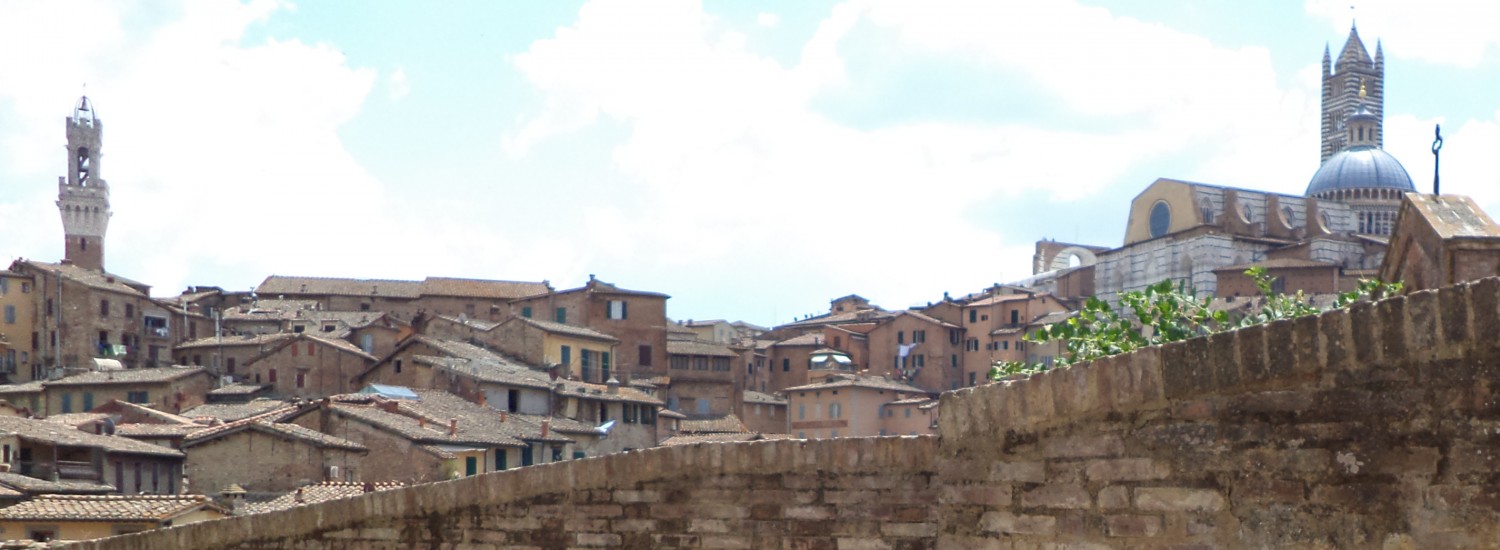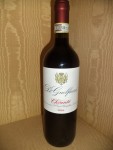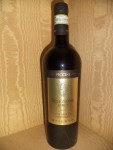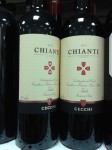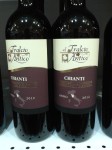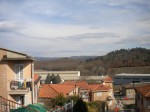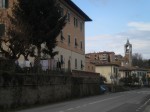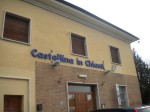 This time is something about Siena’s typical food on request Genevieve Hassall (www.thewanderbug.com) that started her second website Global Gourmand (www.theglobalgourmand.com). The aim of this website is to help travellers before a trip, to discover the food of the place. In her E-mail she asked me to write a guest post about the food in Siena.
This time is something about Siena’s typical food on request Genevieve Hassall (www.thewanderbug.com) that started her second website Global Gourmand (www.theglobalgourmand.com). The aim of this website is to help travellers before a trip, to discover the food of the place. In her E-mail she asked me to write a guest post about the food in Siena.
For me it is a great idea. I know that all of you know very well Italian pasta, pizza, coffee or gelato. However knowledge about Siena’s delicacies is not so common. What is more it is very useful to have this knowledge when you are here. So let’s start!
1. Ricciarelli di Siena
 Ricciarelli are biscuits with origin in the Tuscan city of Siena dating to the 14th century. According to legend they were introduced by Ricciardetto della Gherardesca in his castle near Volterra.
Ricciarelli are biscuits with origin in the Tuscan city of Siena dating to the 14th century. According to legend they were introduced by Ricciardetto della Gherardesca in his castle near Volterra.
But let’s come back to the present and our reality! What’s the recipe? And here lucky me! My favorite almond is a main ingredient. Thus the unique biscuits are made using an almond base with sugar, honey and egg white. Traditionally almonds are ground with a milling machine. After this they are formed into mostly oval-shaped cookies, and then are left for 2 days to be baked. Their surface is usually lightly sprinkled with confectioner’s sugar.
Yes they are sweet, but I can guarantee you that one biscuit will be not enough for you. Only their price (small box costs about 6EUR) or calories (about 500 kcal per 100 gr) can stop you but maybe it will be not a big deal for you. The best for sure is a soft heart of Ricciarelli that melts in your mouth. Welcome to the seventh heaven!
Formally time for Ricciarelli is Christmas . . . but if you are in Siena you will notice that their best time is ALWAYS.
2. Pici di Siena
Pici – type of hand-made pasta, similar to spaghetti but larger and for me much tastier that originates in the province of Siena.
The recipe is extremely simple: water, flour and very little, if any, egg. The taste is other than normal pasta and a bit hard to describe. But you know what . . . it is not necessary to describe. It is better that you become convinced of its amazing taste alone!
You can eat this pasta at a variety of ways i.e.: briciole – with breadcrumbs; aglione – with spicy garlic tomato sauce (my favorite); boscaiola – with porcini mushrooms; ragù – a meat based sauce.
Pici you can buy in Siena everywhere – supermarkets or small shops. It is more expensive then another pasta (even four times) but is unique and I am sure you can’t find it in your place! That’s why you should find it here! Price per 500 grams is about 2-3 EUR. How I convinced recently it is also possible to get truffle Pici.
3. Panforte di Siena
 Panforte di Siena – is another our local delicacy, also the most popular in Christmas time but available throughout the year.
Panforte di Siena – is another our local delicacy, also the most popular in Christmas time but available throughout the year.
Panforte is called as a traditional Italian dessert that contains fruits (for example candied orange and cedro peel) and nuts (mostly my almonds). It is derived of course from Siena. Can you imagine that from 13th century. It is like tasting history! What is more ‘’(…)documents from 1205 show that panforte was paid to the monks and nuns of a local monastery as a tax or tithe which was due on the seventh of February that year(…)’’(http://en.wikipedia.org/wiki/Panforte).
Panforte (literally “strong bread”) has very characteristic look – thick and dense cake. And it seems hard to prepare. But as everything to eat in Italy it is simple to make (fortunately)!
Thus sugar is melted in honey and various nuts, fruits and spices are mixed together with flour. This everything is then baked in a flat pan. So easy, isn’t it? The taste is for me unique and totally priceless. For sure the most impact have spices and perfect quantity of ingredients. In Siena it is sometimes said that Panforte has to have seventeen different ingredients that reflects the number of Contrade.
Here as you will for sure notice our Panforte occurs in a variety of sizes, tastes and wrappings. That is why price is different. Certainly it is not a cheap tidbit! But as you can guess for sure it is worth its price! What is more you shouldn’t even consider how much you have to pay! Then you can enjoy the uncommon taste with for example cup of coffee or glass of wine!
Trust me without it you shouldn’t leave Siena.
4. Il Panettone!
Il Panettone is tradition for Christmas and New Year. 
It is sweet bread loaf from Milan and is a symbol of this city. But it is popular not only in Italy but also, inter alia in Spain, Portugal, Brazil, Peru, Malta, Germany and Switzerland!
As I wrote the cake is derived from Milan, from the time of Ludovico il Moro, and it is still produced according to the 500 years ago. In Milan until 900 were among many bakers and confectioners to produce the cake, but today large industrial firms that are located in Italy produce il Panettone. However in Milan are still many artisans who produce a cake according to the traditional recipe.
Il Panettone has characteristic shape (cupola shape) and packaging (1kg weight, in tall decorated boxes).
Unfortunately preparing process lasts long and involves the curing of the dough (made with water, flour, butter, eggs) which is acidic. The proofing process takes some days and gives the cake its characteristic fluffiness.
The best what you can find is of course inside: candied fruits(citron, orange); raisins ; lemon zest as well as chocolate. The result is commonly referred panetton CANDIO.
What is more here and there il Panettone can be served with crema di mascarpone.
Panettone you can find easily in supermarkets or smaller shops. You should only remember that cake is generally only available seasonally.
Then only get your slice of this dainty and enjoy the great taste with a glass of sweet wine (for example Asti or Moscato d’Asti) or sweet hot beverages.
5. Chianti
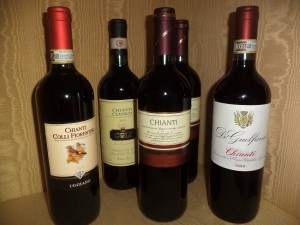 Wine that is produced in the Chianti region, is extending roughly over the two main city provinces of Florence and Siena. And certainly it is known around the world.
Wine that is produced in the Chianti region, is extending roughly over the two main city provinces of Florence and Siena. And certainly it is known around the world.
Can you imagine that the earliest documentation of a “Chianti wine” dates back to the thirteenth century!? Just then merchants in the nearby townships of Castellina, Gaiole and Radda formed the Lega del Chianti that was formed to produce and promote the local wine.
What is more and probably you don’t know is the fact that the earliest incarnation of Chianti was as a white wine. And by the eighteenth century, Chianti was widely recognized as a red wine.
By the late twentieth century, Chianti was often associated with basic Chianti sold in a squat bottle enclosed in a straw basket, called a fiasco. However, during the same period, a group of ambitious producers began working outside the boundaries of DOC regulations to make what they believed would be a higher quality style of Chianti. Important here was year 1984, in which Chianti obtained the denomination D.O.C.G. (Denominazione d’Origine Controllata e Garantita) which is the highest type of protection and recognition for quality Italian wines.
You can’t miss occasion to try Chianti Classico – premium Chianti wines that tend to be medium-bodied with firm tannins and medium-high to high acidity. Floral, cherry and light nutty notes are characteristic aromas with the wines expressing more notes on the mid-palate and finish than at the front of the mouth.
Since 1996 the blend for Chianti and Chianti Classico has been 75-100% Sangiovese, up to 10% Canaiolo and up to 20% of any other approved red grape variety such as Cabernet Sauvignon, Merlot or Syrah. Since 2006, the use of white grape varieties such as Malvasia and Trebbiano have been prohibited in Chianti Classico that must have a minimum alcohol level of at least 12% with a minimum of 7 months aging in oak.
So now it only remains to enjoy the taste of this Tuscan treasure!
6. Cavallucci di Siena and Cantuccini
These are another (characteristic for Christmas) so popular in Siena pastry made with anise, almonds, candied fruits, coriander, and flour. It has an Italian origin which translates approximately to “Little Horses”. What is more traditionally is used Tuscan millefiori honey as an essential element for the biscuits.
The history of Cavallucci dates back to the 16th century. Many theories are associated with the origin of its name. According to the most popular version of the story, Cavallucci was served to travelers on horseback as a source of nourishment for long trips.
On the other hand different versions have said that these sweets were the usual snack of servants who worked in horse stables of rich Italian aristocrats, in a city which gained its fame for horse racing.
Strong relationship with the horse emphasizes the fact that these cookies were originally imprinted with the image of horse.

Cantuccini are twice-baked cookies originating in the Italian city of Prato. The biscuits are oblong-shaped almond biscuits, made dry and crunchy through cutting the loaf of dough while still hot and fresh from baking in the oven.
And the most important is as always the recipe. Ingredients are: flour, sugar, eggs, pine nuts; and almonds that are not roasted or skinned. What is more the traditional recipe uses no form of yeast or fat. After a dough is cooked twice: once in slab form, and after cutting in sliced form, with the second baking defining how hard the biscotti are. And then is the biggest pleasure – taste. Cantuccini can be served after dessert with orange juice or with one of Tuscan wines. But also with coffee. Your choice!
For me and I guess not only, travel isn’t just only sightseeing. It is also (how important) tasting the place that we visit. It is priceless to relish local, typical goodies as well as to buy and take some of them home. Isn’t it a great souvenir?
So what remains? Wish you buon appetito! Especially here in Siena!
Magdalena
http://justvisitsiena.com/
©All Rights Reserved.
